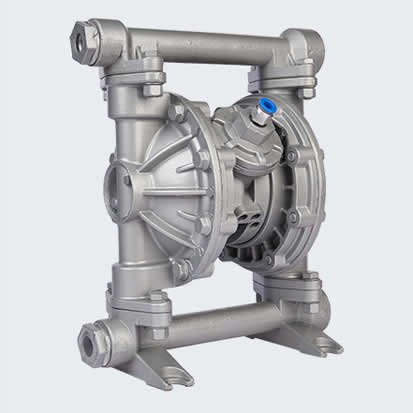
China Pumping Solutions Leader
Pneumatic diaphragm pump depends on the air compressor to input compressed air into the distribution valve of the diaphragm pump, drive the link shaft in the middle body, drive the diaphragm in the medium chamber of the pump body to do transverse tensile movement, so as to achieve the role of self-priming medium.
Working principle of pneumatic diaphragm pump when the compressed air through the valve into the left diaphragm medium chamber, the diaphragm pressure out, and the formation of compression stroke, in the pressure department of the medium force to leave the left outer diaphragm chamber through the ball core seat and the busbar, and then by the outlet end of the pump out, The outlet position can be at the top, bottom, or side (according to customer requirements or pipe change inlet and outlet direction). Arranged at the top or bottom of each outer diaphragm chamber or sharing an inlet and outlet tube. The diaphragm chamber is connected by the suction port and the outlet joint. The pump is self-priming to achieve the suction medium. When the diaphragm plate of the left diaphragm chamber is pushed out under pressure, the diaphragm link shaft pulls the right diaphragm inward in the intermediate body to retract and fill with fluid. After this circulating action is completed, the valve will automatically change its position, so that the air will be switched to another diaphragm chamber, and the above circulating action will be repeated in reverse, that is, the diaphragm chambers on both sides will therefore present alternating compression stroke and pumping medium action.
In actual operation, the link shaft in the distribution valve pushes the pressurization of the alternating action of the control diaphragm. After each stroke, the air distribution valve will automatically change the direction of the air source, so that the air can be switched to the other side of the diaphragm chamber, so that the two sides of the diaphragm chamber to form alternate suction and press stroke action, diaphragm diaphragm compression work in the liquid chamber, the air distribution valve no oil lubricating oil demand, clean, dry air can improve the performance of the pump
Therefore, pneumatic diaphragm pump has the following characteristics:
(1) the pump will not overheat: compressed air for power, in the exhaust is an expansion of the process of heat absorption, pneumatic pump working temperature is reduced, no harmful gas discharge.
(2) Can pass through the liquid containing particles: because of the positive displacement work and the inlet is ball valve, so it is not easy to be blocked.
(3) No dynamic seal, easy maintenance to avoid leakage. There are no dead ends at work
(4) small size, light weight, easy to move.
(5) can be empty operation, without danger.
(6) can dive work.
(7) the shear force of the material is very low: how to suck in how to spit out when working, so the agitation of the material is minimal, suitable for the transport of unstable material
(8) The flow can be adjusted, and the throttle valve can be installed at the outlet of the material to adjust the flow.
(9) Has the function of self-priming.
(10) The pump can always maintain high efficiency, will not be reduced because of wear.
(11) A wide range of fluids can be transported, from low viscosity to high viscosity, from corrosion to viscosity.
(12) No complex control system, no cables, fuses, etc.
(13) No lubrication so easy maintenance, will not pollute the working environment due to drip.
(14) 100% energy utilization. When the outlet is closed, the pump will automatically stop, and the equipment will move, wear, overload and heat
(15) no electric spark: pneumatic diaphragm pump does not use electricity for power, after grounding and prevent electrostatic sparks
